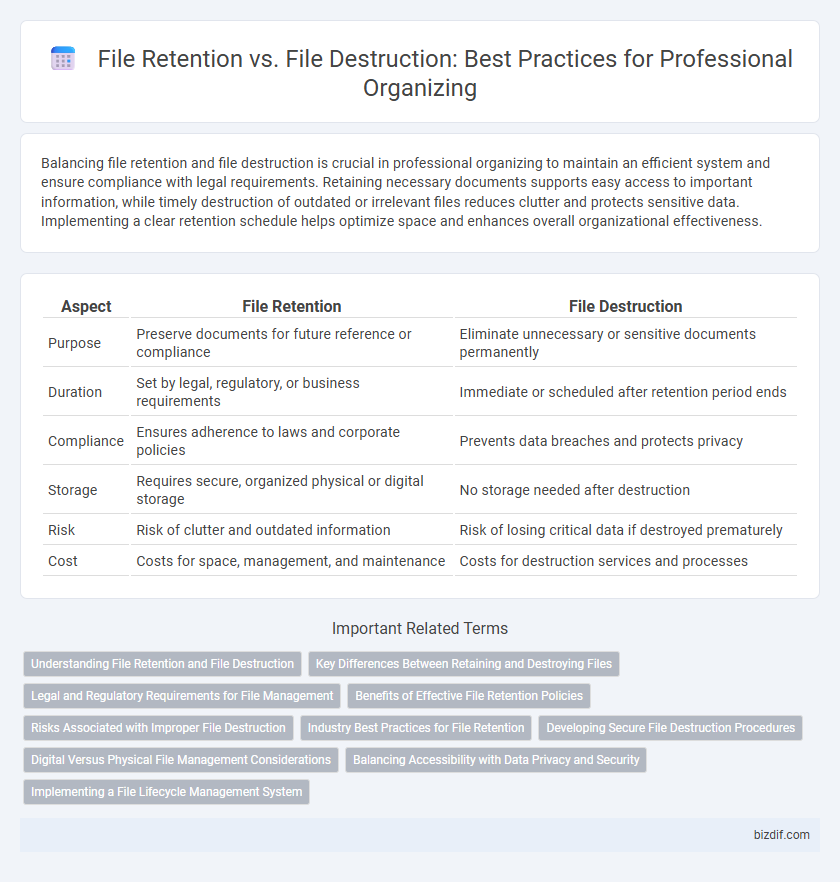Balancing file retention and file destruction is crucial in professional organizing to maintain an efficient system and ensure compliance with legal requirements. Retaining necessary documents supports easy access to important information, while timely destruction of outdated or irrelevant files reduces clutter and protects sensitive data. Implementing a clear retention schedule helps optimize space and enhances overall organizational effectiveness.
Table of Comparison
| Aspect | File Retention | File Destruction |
|---|---|---|
| Purpose | Preserve documents for future reference or compliance | Eliminate unnecessary or sensitive documents permanently |
| Duration | Set by legal, regulatory, or business requirements | Immediate or scheduled after retention period ends |
| Compliance | Ensures adherence to laws and corporate policies | Prevents data breaches and protects privacy |
| Storage | Requires secure, organized physical or digital storage | No storage needed after destruction |
| Risk | Risk of clutter and outdated information | Risk of losing critical data if destroyed prematurely |
| Cost | Costs for space, management, and maintenance | Costs for destruction services and processes |
Understanding File Retention and File Destruction
Understanding file retention involves knowing the legal, regulatory, and operational requirements that dictate how long documents must be kept to ensure compliance and accessibility. File destruction is the secure process of disposing of records once they exceed their retention period, preventing data breaches and reducing clutter. Effective professional organizing integrates both practices to maintain organizational efficiency and information security.
Key Differences Between Retaining and Destroying Files
File retention involves maintaining documents for legal, operational, or historical purposes, ensuring compliance with regulatory requirements and facilitating easy access when needed. File destruction, on the other hand, aims to securely eliminate records to protect sensitive information and free up physical or digital storage space. Key differences include retention periods dictated by laws or policies versus destruction timelines focused on data security and risk mitigation.
Legal and Regulatory Requirements for File Management
File retention and file destruction are governed by specific legal and regulatory requirements that mandate how long certain documents must be kept to ensure compliance and mitigate risk. Compliance with laws such as HIPAA, GDPR, and Sarbanes-Oxley requires organizations to retain files for prescribed periods while securely destroying records that exceed retention schedules to prevent unauthorized access and data breaches. Proper implementation of file retention policies aligned with these regulations helps professionals avoid penalties, supports regulatory audits, and protects sensitive information throughout its lifecycle.
Benefits of Effective File Retention Policies
Effective file retention policies protect sensitive information while ensuring compliance with legal regulations, reducing risks of data breaches and penalties. Streamlined document management improves organizational efficiency, making retrieval and auditing processes faster and more accurate. Proper retention schedules also lower storage costs by eliminating unnecessary files, optimizing digital and physical storage space.
Risks Associated with Improper File Destruction
Improper file destruction exposes businesses to significant risks including data breaches, identity theft, and legal penalties for non-compliance with regulations like GDPR and HIPAA. Sensitive information left unsecured can lead to financial loss, reputational damage, and potential lawsuits. Implementing secure shredding and digital data wiping protocols minimizes these risks and ensures compliance with data protection standards.
Industry Best Practices for File Retention
Industry best practices for file retention emphasize maintaining records only as long as necessary to comply with legal, regulatory, or business requirements, typically ranging from 3 to 7 years depending on the document type. Proper categorization and secure storage of files ensure easy retrieval and protect sensitive information while reducing clutter and minimizing risk. Scheduled reviews and destruction protocols help organizations avoid unnecessary data accumulation, support compliance audits, and safeguard against data breaches.
Developing Secure File Destruction Procedures
Developing secure file destruction procedures requires identifying sensitive information and complying with legal retention mandates to balance file retention and destruction effectively. Implementing methods like shredding, incineration, or electronic wiping ensures confidential data is permanently destroyed, reducing risks of identity theft and data breaches. Regular audits and staff training on destruction protocols maintain compliance and safeguard organizational integrity in professional organizing.
Digital Versus Physical File Management Considerations
Digital file management requires regular assessment of data storage capacity, security protocols, and compliance with privacy regulations, while physical file management demands consideration of space limitations, accessibility, and environmental factors such as fire or water damage. File retention policies must align with regulatory requirements like GDPR or HIPAA for digital files, whereas physical documents often require secure shredding or disposal methods to prevent identity theft. Balancing digital versus physical file retention optimizes organizational efficiency, reduces clutter, and ensures legally compliant destruction practices.
Balancing Accessibility with Data Privacy and Security
File retention policies ensure that important documents remain accessible for operational and legal purposes, while file destruction safeguards sensitive information from unauthorized access and data breaches. Balancing accessibility with data privacy and security requires implementing secure storage solutions combined with systematic review schedules to identify obsolete files for secure disposal. Employing encryption and strict access controls during the retention period enhances compliance with regulations like GDPR and HIPAA while minimizing risk.
Implementing a File Lifecycle Management System
Implementing a file lifecycle management system maximizes efficiency by defining clear retention schedules based on regulatory requirements and business needs, ensuring files are preserved only as long as necessary. Automated policies streamline the transition from active use to secure archival or destruction, minimizing risks of data breaches and non-compliance. This systematic approach optimizes storage costs and enhances information governance through consistent evaluation and execution of file retention and destruction protocols.
file retention vs file destruction Infographic

 bizdif.com
bizdif.com